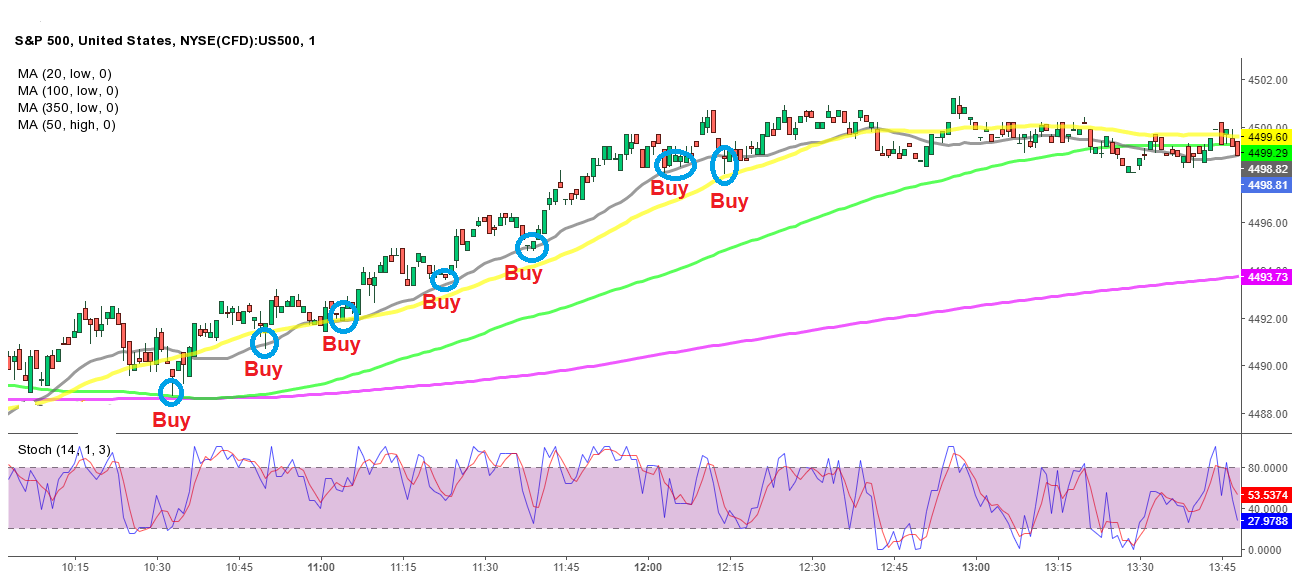Stock Signals
, News &Analysis - FX Leaders
been around as trade recommendations since the early years. Nowadays, there are many
providers of stock signals, with various different trading types, in terms of signals
and the backgrounds behind them. They are a very important tool for stock traders and
forex traders in general to use in their operations. They are available either for a
fee or for free from stock signals providers. We at Fxleaders also provide stock signals,
alongside forex signals, cryptocurrency signals and commodity signals.
8 Most Common Stock Trading Indicators for Beginners
Every financial assets trader needs a good understanding of technical indicators. The understanding must not be as deep, but it’s crucial to Full Article
How to Identify Stock Takeover Targets
Takeovers, also known as acquisitions or mergers, are big news in the stock market and offer shareholders the potential for big returns. Full Article
Automated Vs. Manual Stock Trading Signals
Stock trading signals are indicators or suggestions that traders use when making decisions on whether to buy or sell a stock. Full Article
How to Generate Buy and sell Signals of stock trading?
Introduction to stock trading can be an intimidating concept for those just getting started. Full Article
How to Invest in Stocks: Quick-Start Guide
Stocks are a type of security that represents ownership in a company. When you buy a stock, you are essentially buying a small piece of the Full Article
How to Trade (AMZN) Amazon Stock
Trading Amazon's stock (AMZN) can be an exciting yet challenging endeavour for experienced investors and newcomers alike. Full Article
How to Trade (AAPL) Apple Stock
In this article, we will be discussing how to trade Apple's (AAPL) stock. Apple is one of the largest and most valuable companies in the wor Full Article
How to Use Stock Trading Signals?
It is common for newbie traders to entertain lofty ambitions or investment objectives when they first enter the stock market. Full Article
How to Use Stock Volume as a Trading Signal?
Welcome to the wonderful world of stock trading! In this blog section, we will discuss how to use stock volume as a trading signal. Full Article
The 9 Best Technical Indicators for the Stock Market
The 9 best technical indicators for stock market analysis is an article about the best tools for helping traders identify trends, overbought Full Article
Trading Fidelity With Stock Signals
Fidelity is a well-known and respected financial services company that offers a wide range of investment products and services to individual Full Article
Trading Robinhood With Stock Signals
Robinhood is a popular stock trading app that allows users to buy and sell stocks, options, and other securities on the stock market. Full Article
What are stock trading signals? Beginners Guide 2023
Stock signals refer to pointers that show stock or index could be approaching a trend reversal or breakout. These signals can come from.... Full Article
What Are Stock Signals
Stock signals are trade recommendations for potentially profitable trade opportunities in the stock markets. They can be either signals for trading shares of individual companies or signals for trading stock indices. Trade signals are also called “trigger-for-action” and come with some parameters attached to them.
- Signal – Company name or index name
- Action – Buy or sell
- Entry Price – Where it is recommended to open a trade or already have one open
- Stop Loss – Stop loss target for the trade
- Take Profit – Take profit target for the trade
Stock signals can be as complex as you want, but signals issued with all the levels, as above, are considered complete signals. Otherwise, they might be trade recommendations, but they wouldn’t be complete, since that would require a decent level of market knowledge on the part of the trader, whereas in the case of a complete stock signal, someone could copy them without knowing much about trading.
Stock signals don’t trigger trades automatically, as in the case of a trade copier. Traders still have to execute the trade themselves and decide on the amount they want to invest, and how to manage their money. Stock signals may or may not have an expiry time/date on them, which means that at that time, the signal is called off if the trade is not triggered. We issue two types of signals here at FX leaders: get ready signals, which means that traders should keep an eye on a particular stock or index, in order to buy or sell, and real time buy/sell signals, with no expiration date. When a signal closes, it also shows whether it hit the take profit or stop loss target.
Autotrading Vs. Manual Signals
The signals we provide here at Fxleaders are generated by experienced market analysts, but automatically generated stock signals, issued by stock trading signal apps for stock algorithms or robots, are also available. They have become quite common in the last decade. Both types of signals can either be profitable or not, depending on their strategy and market conditions, so trading success isn’t too dependent on that. But there are some important differences that all traders who decide to use trading signals should take into consideration, according to the type of trading they do.
Pros of Automated Stock Signals
- No Emotions – One of the biggest advantages that automated stock signals have is that they don’t involve emotions when trading. Traders sometimes get worn out emotionally, and either make mistakes when trading, which increases the risk-reward ratio, or they stay out of trading, which is not a particularly bad thing, but it results in the loss of many good trades. Automated signals eliminate this problem from the equation and perform tasks without thinking about them.
- Discipline – Discipline is one of the hardest things for some people. Traders develop or purchase trading strategies, which could work perfectly well, but they end up losing nonetheless. The reason for this is that they don’t stick to the strategy. Automated trading follows the instructions/parameters that you have programmed, strictly and repeatedly.
- Fast Executions – Some types of markets, such as cryptocurrencies, move very quickly. Sometimes it’s hard to catch the price action, and stock markets can simply be too fast at certain times. Trading bots can execute trades very fast, which makes them great for arbitrage trading, especially in the crypto market, as such trading algorithms make use of the price differences for different brokers. This also helps a lot during news releases, which could send stock up or down so fast that a human would normally miss it.
- Round the Clock Coverage – Humans need to sleep and take care of personal things, as well as working, so they can’t track markets around the clock. Stock markets around the world close at different times, but nobody can trade different stock markets around the world 24 hours a day. Auto traders can follow all markets around the world and issue stock signals at any time, when they spot a good trade that fits the strategy. This way, they can also diversify trading with instruments that a person doesn’t follow, since a single trader normally concentrates on 5-10 instruments/stocks.
Pros of Manual Stock Signals
- Gaining Experience – With auto stock signals, traders might become lazy and lose out on the experience that they might get from analyzing markets and trading themselves. When trading themselves, traders get real time experiences, which help them grow, both technically and fundamentally.
- Better Control – Trades need to be followed and nursed. A stock signal provider could not do that, since they usually issue the signal with the parameters, and that’s it. If market forces change during the time that the trade is open, you don’t get any more instructions on how to act. Human traders can follow trades closely and increase or decrease leverage, or perform other actions, as required by market conditions.
- Maximizing Profits – Once you know how to trade in the stock market by yourself, you can nurse the trades and maximize your profits by pushing the Take Profit target further when markets are going in the right direction. Or, in the opposite scenario, you can cut losses short by closing trades earlier than the Stop Loss target. Automated trading can’t do that.
Trading Analysis Supporting our Stock Signals
Fxleaders is a stock signals provider, and we issue stock signals continuously. We base our strategy on different indicators and take both the technical and fundamental picture into account. One of the stock indices that we often provide signals on is the German Dax30 index. Here, we take a look at the whole picture in Dax and S&P500.
Looking at the daily chart in Dax30, you can spot many great buying opportunities since the low from the coronavirus crash in early 2020. We have taken some of these trades, based on our analysts’ strategies, making some nice profit during this time, with the signals that we have provided.
But, even for a robot, it would be hard to spot/take all these good trades, because usually the algorithmic trading picks a moving average and buys against it. If the signal app for stocks that you use has picked the 50 SMA (yellow), for example, it would miss the trades at the 20 SMA (gray) and it would lose the trades as soon as the price fell below the 50 SMA, to the 100 SMA (green). Our analysts evaluate the price action when it gets close to these moving averages, and if it shows signs that it wants to reverse, and the stochastic indicator is oversold, they will take the trade. If not, they will stay out and wait for the price to retreat further down, to a bigger MA.
The picture in S&P500 is much clearer. We have three good trading opportunities, at the 20 SMA (gray), six trading opportunities at the 50 SMA (yellow), two at the 100 SMA (green) and two at the 200 SMA (purple). We can’t say we took them all over this period, but it would be much easier to spot these opportunities as a human trader than is likely if you were to rely on getting stock signals from a signal app.
Technical Vs Fundamental Stock Signals
When deciding whether you want to receive signals from a signal app for stocks or from a stock signal provider with human analysts, you should also see what sort of strategy they employ for their stock signals. Strategies are separated into two main categories: Technical Analysis and Fundamental Analysis. Both have their strengths and their flaws, and they can be further divided into more specific trading strategies.
Important Fundamental Strategies
- Carry Trade – With this type of strategy, you pick the assets that offer the best returns, which can be in the form of interest rates or in the case of stocks, those that offer the highest dividends. You can also sell the stocks with the smallest dividends, against buying the ones with the highest ones.
- Trading the News Releases – Both human traders and trading bots are good for this type of strategy. Algo trading makes the most of economic news releases, since they can read and react to them very fast, e.g. manufacturing data or earnings for a certain industry, such as electronics. Human traders are better at reading the comments from different important people, such as CEOs of major companies, economists, politicians etc.
- Trading Central Banks – Trading central banks is like trading the news. Robotic traders do better during interest rate decisions, since they react very fast – within milliseconds of the release – while human traders do better at interpreting and trading the rhetoric and the comments by major bankers.
- The Market Sentiment Strategy – The market sentiment is very important in all types of markets, since it is what drives the price up and down for any asset, at a specific moment. There are Algorithms that read the market sentiment, but they still can’t do it as well as an experienced human trader. You can see what direction the price has been going until a certain time, but it doesn’t necessarily mean that it will continue to go in that direction. The sentiment is quite fluid, so experience is better than automated trading, when it comes to reading the sentiment.
Important Technical Strategies
- Support and Resistance – This is one of the most popular technical strategies. As the name suggests, you basically use the previous horizontal levels when trading. We know that what was once support turns into resistance and vice versa. So, buying at a resistance level after it has been broken, once it turns into support, is not a bad idea.
- Following Trends – One of the first rules to learn in trading is to never go against a trend. Trends are the most powerful thing in any market, so going against the trend means going against the market or the majority of traders. Instead, it is much more profitable to go with the flow and use the trendlines to buy or sell. The price usually jumps off a trendline after some time, so buying at a trendline during a bullish trend or selling during a bearish trend can be very useful.
- Candlestick Formations – Candlesticks in themselves and candlestick patterns, which include a number of candlesticks, are very useful for indicating reversals. They signal when a wave is about to end and another is about to begin. They are great at indicating the end of a retrace during a trend, such as in the case of the S&P and Dax highlighted above. There are many single candlestick formations, such as Doji, Hammer, Pin, Evening and Morning Star etc., and many more multiple candlestick patterns such as the Bullish/Bearish Engulfing pattern, Three White Soldiers etc.
Stock Signals for Scalpers and Day-Traders
Scalping is a trading strategy that consists of smaller trade targets, but more in terms of the number. It is usually based on smaller timeframe charts, such as the 1-minute, 2-minute, 5-minute and 15-minute charts. This is a popular strategy for beginner traders, as it consists of several pips of profit/loss. This sort of trading usually works against moving averages, during trends and between short term support and resistance levels, when markets trade sideways.

Stock signals for scalping are trading suggestions to buy or sell for a small profit or a small loss. Such signals help stock traders to make small gains during small market fluctuations. If you are registered with a stock signals provider that uses such a trading strategy, you should receive stock signals to trade pretty often, and round the clock, since this sort of strategy works in all types of markets. Also, such signal providers usually use signal apps for stocks, since trading algorithms work faster than human traders and they are great for smaller but more frequent trades.
How to Trade Stock Signals
Stock signals are the same as all other types of signals. In most cases, a stock signal is issued by a professional trader or a stock trading algorithm, based on the strategy that they have chosen. When they see a trade setup that triggers their strategy, they issue a buy/sell signal, which should include the entry price, the take profit and stop loss and, of course, the asset.
The trader then decides whether or not to enter that trade, based on that signal. But in most cases, providers of stock signals don’t offer money management with their trade signals. Traders have to make the calculations themselves, decide how much they want to risk and choose the amount of lots/mini-lots, according to their money management rules. If the signal provider uses a good strategy, you will see the results at the end of the month, if not, you will suffer the losses, therefore it is good to test signal providers for some time first.
 GET ALERTS
GET ALERTS










